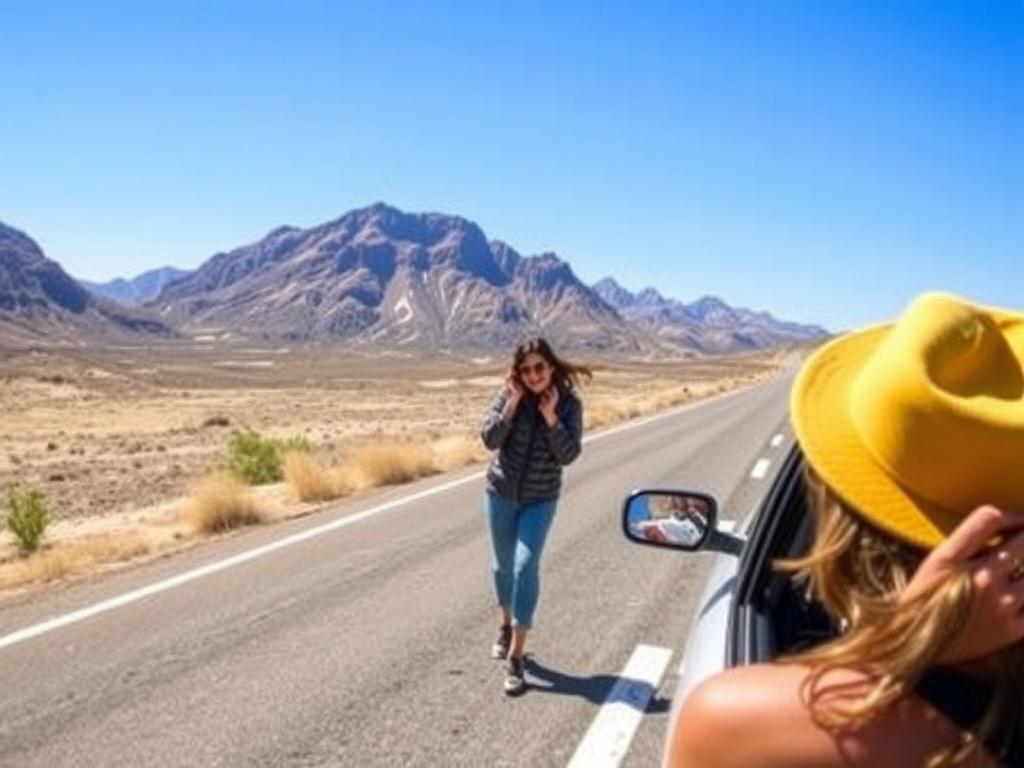Hitchhiking has captured the imagination of adventurers for decades. The idea of standing by the roadside with your thumb out, hoping a stranger will offer you a ride across vast lands, evokes a sense of freedom, spontaneity, and connection with the unknown. But as exciting as it sounds, the question on many travelers’ minds is: Is hitchhiking across continents safe? The answer is nuanced and depends on various factors such as the countries you plan to traverse, the preparation you undertake, social attitudes, and your personal instincts. In this article, we’ll take a deep dive into the safety considerations of hitchhiking across continents, helping you weigh the risks and rewards so you can make an informed decision.
What Does Hitchhiking Across Continents Mean?
When people talk about hitchhiking, they often imagine a small trip between towns or maybe a stretch of a day’s travel. But hitchhiking across continents means embarking on a much longer journey, traveling through different cultures, climates, and terrains—sometimes covering thousands of miles. It’s not just about hopping into cars; it’s about immersing yourself into the lives of people around the globe, navigating languages you may or may not speak, and adapting to varying road rules and social norms.
Many travelers set out from Europe to Asia, traverse parts of the Americas from north to south, or explore the diverse landscapes of Africa this way. Each continent presents its unique challenges and opportunities that affect the overall safety and experience of hitchhiking.
Why Do People Choose to Hitchhike Across Continents?

Before diving into safety concerns, it’s important to understand what motivates travelers to choose hitchhiking over other modes of transport. Here are some reasons why hitchhiking remains an appealing option:
- Affordability: Hitchhiking is practically free, which makes it ideal for budget travelers and backpackers.
- Connection with locals: Unlike bus or train travel, hitchhiking can lead to meaningful interactions with drivers and locals.
- Adventure and spontaneity: It offers a thrilling unpredictability that packaged tours or scheduled transport cannot.
- Flexibility: You can change plans on the go without strict schedules.
- Environmental impact: It’s considered a more sustainable way to travel as it utilizes existing resources.
However, the flip side includes potential risks that can vary dramatically based on where you are and whom you encounter.
Key Factors That Influence Safety When Hitchhiking Across Continents
Understanding the landscape of safety means assessing multiple dimensions. Let’s explore some of the main factors that shape whether hitchhiking is safe or not.
Geographical and Political Context
Some regions are inherently riskier due to unstable political situations, ongoing conflicts, or widespread lawlessness. For example, hitchhiking in parts of Central America or some areas in Africa may involve higher risks than in Western Europe or certain parts of Asia. Researching the political climate and checking travel advisories from reputable sources such as government websites or international travel forums is crucial before your trip.
Local Attitudes Toward Hitchhiking
In some countries, hitchhiking is a common and culturally accepted practice, while in others it may be viewed with suspicion or even considered illegal. For example, countries like Germany, Iceland, and New Zealand have long histories of hitchhiking and communities that support and encourage it. On the contrary, in some U.S. states and parts of Asia, it might be banned or frowned upon, impacting your chances of getting a ride and your overall safety.
Time of Day and Location
Safety often fluctuates depending on where and when you decide to hitch a ride. Standing on a secluded rural road at night can exponentially increase dangers compared to well-populated highway stops during daylight hours. Lighting, traffic volume, and availability of safe waiting areas all come into play.
Your Own Preparedness and Awareness
Ultimately, the traveler’s attitude, preparation, and instincts often make the biggest difference. Researching routes, carrying a reliable means of communication, having backup plans, trusting your gut feeling, and learning some local language basics all contribute significantly to safety.
Common Safety Tips for Hitchhiking Across Continents

For those who are seriously considering this mode of travel, preparing yourself adequately is vital. Here are some practical safety tips drawn from experienced hitchhikers and traveler communities:
| Safety Aspect | Recommended Action | Why It Matters |
|---|---|---|
| Research Your Route | Use online forums, travel blogs, and government travel advisories to understand safety levels. | Avoid dangerous regions and find safer hitchhiking spots. |
| Keep Valuables Hidden | Carry only essential items visible; store valuables securely. | Prevents attracting unwanted attention or theft. |
| Dress Appropriately | Wear comfortable, modest clothing suitable for local customs. | Helps you blend in and avoid negative stereotypes. |
| Trust Your Instincts | If something feels off, decline a ride politely. | Your gut is often the best early warning system. |
| Share Your Location | Inform a friend or family member about your whereabouts regularly. | Enables help if something goes wrong. |
| Choose Rides Wisely | Prefer rides with individuals who appear sober and friendly. | Minimizes risks associated with reckless or malicious drivers. |
| Have Backup Plans | Know public transport options in case hitchhiking isn’t feasible. | Prevents being stranded or stuck in unsafe areas. |
Real-Life Experiences: Stories From Hitchhikers Across the Globe
One of the best ways to understand the safety of hitchhiking is through firsthand accounts. The world is full of tales—from heartwarming to hair-raising—that amplify both the thrills and perils of hitchhiking.
For example, many travelers recount kind strangers who offered not only rides but also meals, accommodations, and life advice in rural areas of South America. One hitchhiker in Patagonia recalls how locals viewed hitchhiking as an art rather than just transportation, fostering a communal spirit.
On the other hand, stories from hitchhikers in less stable regions show the sharp edge of caution. Some recount close calls involving speeding vehicles, attempts of robbery, or being dropped in unsafe places. Yet, even these tales often come with lessons learned and emphasize the importance of vigilance.
This wide range of experiences suggests that while dangers exist, they are not universal—and safety can often be managed with the right approach and mindset.
Comparing Safety Across Continents

The safety perception and reality can vary widely depending on where you are. Here’s a comparative overview highlighting typical safety conditions for hitchhiking on different continents:
| Continent | Safety Level | Common Risks | Positive Factors |
|---|---|---|---|
| Europe | Generally High | Urban crime, some rural isolation | Good infrastructure, positive local attitudes, reliable communication |
| Asia | Varies | Language barriers, traffic dangers, political instability in some regions | Generous hospitality in many cultures, growing traveler networks |
| North America | Moderate | Long distances, remote areas, some areas with low hitchhiking acceptance | High road safety standards, widespread access to help services |
| South America | Moderate to Low | Crime risk in certain urban areas, road conditions | Warm local hospitality, stunning landscapes |
| Africa | Low to Moderate | High crime in some regions, political unrest, poor road infrastructure | Rich cultural experiences, strong community ties in some areas |
| Australia & Oceania | High | Remote distances, extreme weather | Friendly locals, good infrastructure |
Legal Considerations When Hitchhiking
In some places, hitchhiking can be restricted by law. Knowing the legal status in each country or region you plan to visit is critical to avoid fines or confrontations with law enforcement. For example, certain U.S. states prohibit hitchhiking on highways, while many European countries have no explicit bans. Countries’ official government travel websites often provide updated information on such laws.
Tips for Navigating Legal Restrictions
- Check official transport and road safety regulations before entering a new country.
- Avoid hitchhiking in restricted areas like highways or tunnels where it’s often illegal.
- Follow local advice and signs marking permitted hitchhiking spots.
- Carry identification and permits (if any) to show authorities if questioned.
How Technology Has Changed the Hitchhiking Experience
In today’s connected world, hitchhiking looks different than it did 50 years ago. Smartphones, GPS, and social media offer new tools for safety and connection. Apps like BlaBlaCar or Hitchwiki provide platforms to coordinate rides, share trusted contacts, and learn from other hitchhikers’ experiences globally. Online communities also allow travelers to form support networks, discuss routes, and warn about dangerous areas.
Technology helps you:
- Track your route in real time to share with friends or family.
- Check maps and public transport as backups.
- Communicate quickly in emergencies.
- Read driver reviews or profiles before accepting rides via ride-sharing apps.
However, technology can’t replace caution and common sense—it complements but does not substitute personal safety measures.
Essential Gear for a Safe Hitchhiking Journey
Packing smart and light is crucial. Here are some items that can enhance safety and comfort during long-distance hitchhiking trips:
- Mobile phone with international SIM or roaming: For communication and navigation.
- Power bank: To keep devices charged during long waits.
- Reflective clothing or gear: Improves visibility, especially in low light.
- Reliable maps (digital and paper): Helps avoid getting lost in areas with no signal.
- Emergency whistle or personal alarm: Can deter potential threats.
- Basic first aid kit: For minor injuries on the road.
- Copy of important documents: Passport, insurance, emergency contacts.
- Reusable water bottle and snacks: Keeps you hydrated and energized while waiting.
Mental Preparation and Mindset for Hitchhiking Safely
Perhaps the most overlooked aspect of safety is the mental and emotional preparation one needs. Hitchhiking can be as much a psychological challenge as a physical journey. Being open-minded, patient, respectful, and adaptable will not only enrich your experience but also enhance your safety.
Mental tips include:
- Stay vigilant but don’t be overly fearful.
- Practice clear communication and body language.
- Learn to read social cues to gauge driver intentions.
- Stay calm in challenging situations to think clearly.
- Embrace the uncertainty as part of the adventure without losing your personal boundaries.
Summing Up the Risks and Rewards
When weighing the question, “Hitchhiking across continents: Is it safe?” it’s essential to balance realistic concerns with the potential benefits. The risks include encountering dangerous individuals, legal complications, and unpredictable environmental conditions. However, with thorough preparation, local knowledge, cautious selection of rides, and respect for personal intuition, many travelers successfully and safely hitchhike across large parts of the world.
To help visualize this balance, here is a simple pro and con table:
| Pros of Hitchhiking Across Continents | Cons of Hitchhiking Across Continents |
|---|---|
| Low cost travel | Exposure to potential crime |
| Chance to meet locals and learn cultures | Variable legal restrictions |
| Flexible and spontaneous itinerary | Physical discomfort in remote or unsafe areas |
| Environmental benefits | Dependence on other people’s schedules and willingness |
| Adventure and personal growth | Language and communication barriers |
Conclusion
Hitchhiking across continents is a compelling way to explore our world, offering experiences full of connection, adventure, and discovery. Nevertheless, safety should always be at the forefront of your planning. It’s neither fully safe nor entirely dangerous—it largely depends on where you go, how well you prepare, and your ability to read situations and people. Embracing hitchhiking means accepting a degree of risk but also recognizing that with proper precautions, respect for local laws and cultures, and an open yet cautious mindset, you can greatly mitigate those dangers. Whether you’re drawn by the thrill of the road or the chance to meet strangers turned friends, always prioritize your safety and remain flexible. After all, the journey itself—navigated wisely—can be one of the most rewarding parts of travel. Happy hitchhiking!









